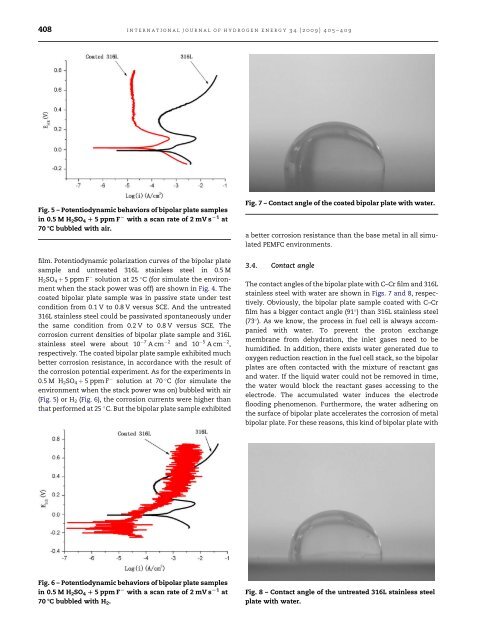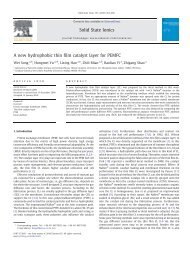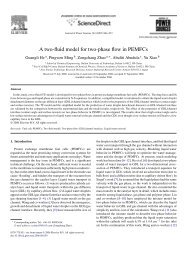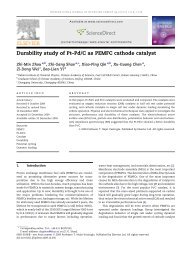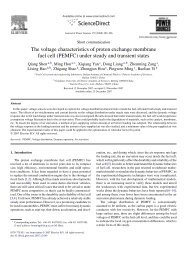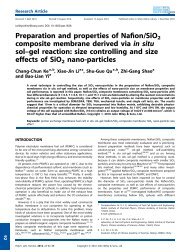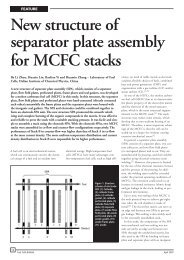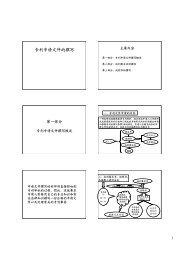Carbon-based films coated 316L stainless steel as bipolar plate for ...
Carbon-based films coated 316L stainless steel as bipolar plate for ...
Carbon-based films coated 316L stainless steel as bipolar plate for ...
Create successful ePaper yourself
Turn your PDF publications into a flip-book with our unique Google optimized e-Paper software.
408<br />
international journal of hydrogen energy 34 (2009) 405–409<br />
Fig. 5 – Potentiodynamic behaviors of <strong>bipolar</strong> <strong>plate</strong> samples<br />
in 0.5 M H 2 SO 4 D 5 ppm F L with a scan rate of 2 mV s L1 at<br />
70 8C bubbled with air.<br />
film. Potentiodynamic polarization curves of the <strong>bipolar</strong> <strong>plate</strong><br />
sample and untreated <strong>316L</strong> <strong>stainless</strong> <strong>steel</strong> in 0.5 M<br />
H 2 SO 4 þ 5 ppm F solution at 25 C (<strong>for</strong> simulate the environment<br />
when the stack power w<strong>as</strong> off) are shown in Fig. 4. The<br />
<strong>coated</strong> <strong>bipolar</strong> <strong>plate</strong> sample w<strong>as</strong> in p<strong>as</strong>sive state under test<br />
condition from 0.1 V to 0.8 V versus SCE. And the untreated<br />
<strong>316L</strong> <strong>stainless</strong> <strong>steel</strong> could be p<strong>as</strong>sivated spontaneously under<br />
the same condition from 0.2 V to 0.8 V versus SCE. The<br />
corrosion current densities of <strong>bipolar</strong> <strong>plate</strong> sample and <strong>316L</strong><br />
<strong>stainless</strong> <strong>steel</strong> were about 10 7 Acm 2 and 10 5 Acm 2 ,<br />
respectively. The <strong>coated</strong> <strong>bipolar</strong> <strong>plate</strong> sample exhibited much<br />
better corrosion resistance, in accordance with the result of<br />
the corrosion potential experiment. As <strong>for</strong> the experiments in<br />
0.5 M H 2 SO 4 þ 5 ppm F solution at 70 C (<strong>for</strong> simulate the<br />
environment when the stack power w<strong>as</strong> on) bubbled with air<br />
(Fig. 5) orH 2 (Fig. 6), the corrosion currents were higher than<br />
that per<strong>for</strong>med at 25 C. But the <strong>bipolar</strong> <strong>plate</strong> sample exhibited<br />
Fig. 7 – Contact angle of the <strong>coated</strong> <strong>bipolar</strong> <strong>plate</strong> with water.<br />
a better corrosion resistance than the b<strong>as</strong>e metal in all simulated<br />
PEMFC environments.<br />
3.4. Contact angle<br />
The contact angles of the <strong>bipolar</strong> <strong>plate</strong> with C–Cr film and <strong>316L</strong><br />
<strong>stainless</strong> <strong>steel</strong> with water are shown in Figs. 7 and 8, respectively.<br />
Obviously, the <strong>bipolar</strong> <strong>plate</strong> sample <strong>coated</strong> with C–Cr<br />
film h<strong>as</strong> a bigger contact angle (91 ) than <strong>316L</strong> <strong>stainless</strong> <strong>steel</strong><br />
(73 ). As we know, the process in fuel cell is always accompanied<br />
with water. To prevent the proton exchange<br />
membrane from dehydration, the inlet g<strong>as</strong>es need to be<br />
humidified. In addition, there exists water generated due to<br />
oxygen reduction reaction in the fuel cell stack, so the <strong>bipolar</strong><br />
<strong>plate</strong>s are often contacted with the mixture of reactant g<strong>as</strong><br />
and water. If the liquid water could not be removed in time,<br />
the water would block the reactant g<strong>as</strong>es accessing to the<br />
electrode. The accumulated water induces the electrode<br />
flooding phenomenon. Furthermore, the water adhering on<br />
the surface of <strong>bipolar</strong> <strong>plate</strong> accelerates the corrosion of metal<br />
<strong>bipolar</strong> <strong>plate</strong>. For these re<strong>as</strong>ons, this kind of <strong>bipolar</strong> <strong>plate</strong> with<br />
Fig. 6 – Potentiodynamic behaviors of <strong>bipolar</strong> <strong>plate</strong> samples<br />
in 0.5 M H 2 SO 4 D 5 ppm F L with a scan rate of 2 mV s L1 at<br />
70 8C bubbled with H 2 .<br />
Fig. 8 – Contact angle of the untreated <strong>316L</strong> <strong>stainless</strong> <strong>steel</strong><br />
<strong>plate</strong> with water.


